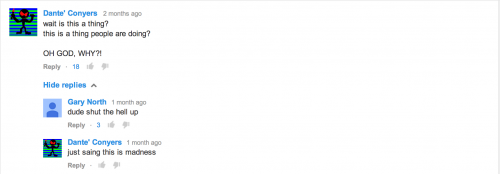
Image Credit:
Screenshot by Deb Streusand
For my course on the Rhetoric of Performance, my students are putting together a brief performance of their own. The idea is for them to learn how performance makes arguments by choosing an argument and putting together a performance to make that argument. Inspired by the Ice Bucket Challenge and John Berger’s work on the visual rhetoric of advertising, they’ve chosen to argue that people participate in viral trends because they want other people to envy them. The students decided that they wanted their performance to embody such viral trends as the Harlem Shake and the cups song; in performing these, they would take on the role of the people who wanted others to envy them. From a performance perspective, they chose to do something highly entertaining, but from a rhetorical perspective, there was something missing. How would we position those performances as undertaken for the purpose of provoking envy?
As teacher-cum-director, I suggested that we have part of the class performing while the rest of the class commented on the performance, and then rotate through different groups of performers and commentators. That way, we could get a viewer’s perspective on each performance. Commenting during the performance would also allow us to show the performers’ reaction to envy.
The students had been watching YouTube videos of the trends they were investigating, which meant that I had spent a lot of time looking at YouTube comments over my students’ shoulders as I supervised their work. I suggested that they start collecting some of these comments and proposed that we make a pastiche. Faced with this unknown word at 4:00 pm, several of them at once asked me, “is that a kind of pastry?” Though they were disappointed to discover that it was not, they dove right into the research to make one. They examined the YouTube comments on these videos in detail and selected the ones that they thought demonstrated envy. Googling “envy quotes” and “envy poems,” they added passages associated with envy to their array of comments. They also wrote their own YouTube-style comments to fill in the blanks when they felt that the pastiche material didn’t express what they needed.
Due to having a lot of other things to cover, we’ve only been rehearsing about 15-20 minutes a class period, so we have yet to stage the performances and use the comments we’ve written up. It’ll be interesting to see how the comments sound aloud, and whether there’s something of the effect described by this XKCD comic. As we rehearse, though, I think we’ll be able to filter and shape our pastiche to make the envy argument clear. (In fact, it’ll be probably be more transparent than the argument of most performances, since many performances do not start out with the idea of making an argument per se. One of my contentions in teaching this course has been that every performance has an argument, but they’re certainly easier to spot in some than in others.) It’s my hope that performing the comment pastiche will help my students understand how timing, intonation, and other performative elements contribute to shaping the meaning of the written word.

